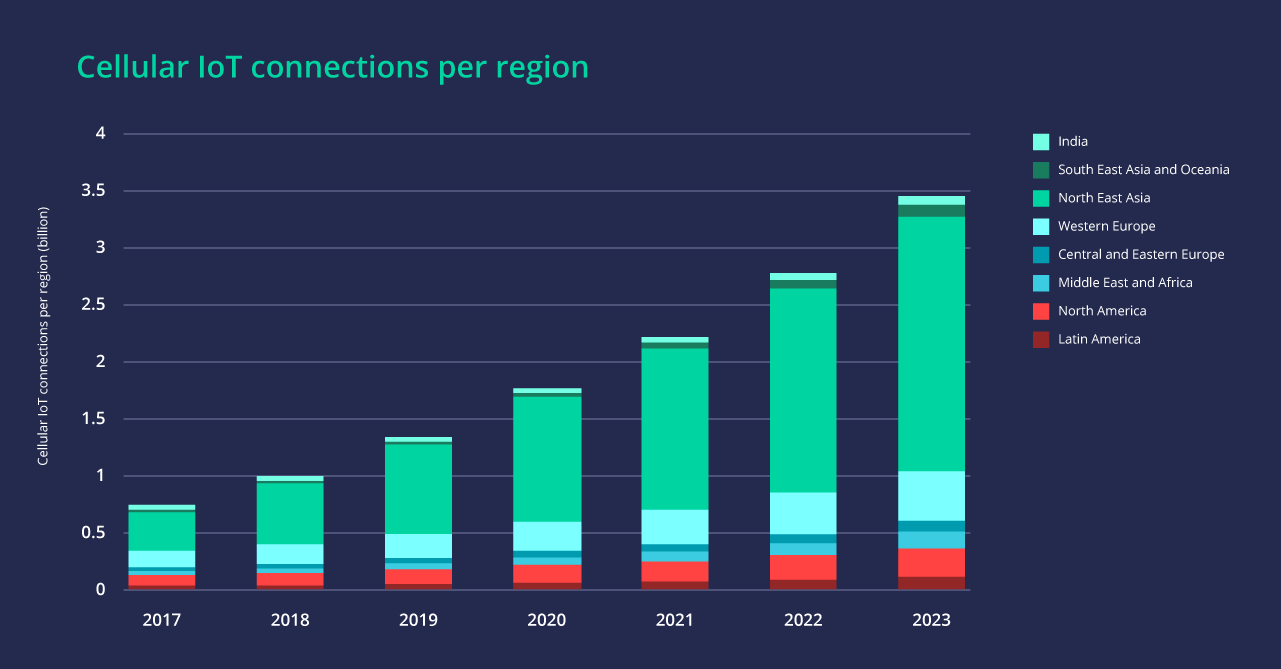With high data rates, low latency, and global reach, SIM-enabled cellular connectivity has fast become an IoT staple.
So much so, that the SIM card technology that was originally designed to bridge the gap between mobile phones and cellular networks can now be found in smart meters, cruise ships, vending machines, hospitals, construction sites… the list goes on. By 2023, Ericsson expects 3.5 billion IoT devices to be connected via cellular, increasing with an annual growth rate of 30 percent.

That’s because regular SIMs lack the versatility, reliability, and control needed for IoT devices (along with having data caps that could shut down your solution mid-use, and device restrictions that make deployments a nightmare).
– Are often constantly on the move, cross-country or across the world
– Require a high volume of SIMs, often in the 100s or 1000s
– Use high data rates that can vary from month to month or SIM to SIM
On the other hand, IoT SIMs are specifically designed with capabilities that meet the needs of IoT devices and the enterprise businesses they’re deployed in.
Regular SIMs vs IoT SIMs: Versatility
But IoT SIMs benefit from completely customisable tariffs and contracts; meaning you only pay for exactly what you need, for however long you need it. Whether you need megabytes, gigabytes, or terabytes of data, 100 or 1000 SIMs, 3 months or 3 years, terms can be adjusted to fit your solution.
And unlike regular SIMs, a single optimised pool of data can be shared across multiple SIMs—cutting costs and preventing overage surprises if one SIM uses more data than another.

Regular SIMs vs IoT SIMs: Reliability
In both cases, you’d need hours of planning to ensure the strongest network is chosen for each SIM based on location. A problem that’s exasperated by no network having perfect coverage or uptime; not to mention the logistics of getting the right SIM to the right location, and the risk of international roaming charges.
But you don’t need to worry about any of this with IoT SIMs. They cut the legwork and risk out of planning even the most complex deployments that need reliable connectivity.
Unsteered multi-network SIMs don’t tie the solution to a single network in a single country. Instead, they let your solutions move seamlessly from network to network, and country to country, with no roaming charges. And if a network drops there’s no interruption in service. Best of all: the device will connect to the strongest network available, because the SIM has no preferred network.
That means there’s no lengthy planning for where the device might go or what network it will need, no risky rollouts that might see SIMs sent to the wrong places, no threat of the device going offline, and no stacks of paperwork; you’ll only ever deal with one provider who’ll give you one contract and one bill for your entire estate.
On top of that, industrial grade or rugged IoT SIMs add an extra layer of resilience for solutions that need to venture into rough terrain, or places with extreme temperatures, like at a remote mountain resort or on a cross-country train.
Regular SIMs vs IoT SIMs: Control
But IoT solutions aren’t nearly as consistent in their data usage. SIMs often go through periods of inactivity, which leaves businesses paying for a service they might not be using or having to tweak their data requirements.
And with large scale deployments it’s tricky to keep track of so many SIMs, let alone visit them in the field to make adjustments or troubleshoot issues (imagine having to trek up a mountain every time!).
IoT SIMs are designed with control, visibility, and longevity in mind. Portals give access to real-time usage information, generate reports, send alerts, and keep track of the SIM’s location; while management tools can be used to remotely troubleshoot, activate, deactivate, block, and cap usage remotely. IoT SIMs can also be provisioned over the air (OTA), and if you opt for an eSIM solution you can even manually change its operator profiles—eliminating the need to swap a SIM in and out.
Also, the availability of static IPs and APIs ensures the connectivity can be integrated into your day to day processes—whether you need to run video conferencing or a Virtual Private Network, or pull SIM information into your own custom applications.
If you’re preparing to get your IoT solution connected it’s important your connectivity is built with versatility, reliability, and control in mind. IoT SIMs won’t just save you money and time; they’re essential in keeping the most mission-critical solutions online.
Need some advice? Drop us a line and we’ll get you set up with a custom IoT connectivity strategy to suit your project—from nailing the right tariffs and terms, right the way through to seamless deployment and long-term support.
Want to read more?

Everything you need to know about LTE-M in the UK

Not selling LTE-M connectivity? You should be

The 3G sunset: Navigating challenges & finding opportunities

PSTN switch-off FAQs: Everything you need to know in one place

Top 10 IoT blog posts of 2022

What the 2G and 3G network sunset means for you and your customers

Everything you need to know about IP addresses and their types

What is LPWAN and what do you need it for?

Everything you need to know about public and private APNs

Five things to consider when choosing an IoT connectivity provider

Your complete guide to the PSTN switch-off: Why you need to act now







Comments are closed.